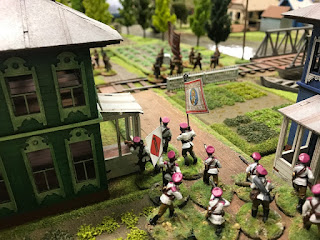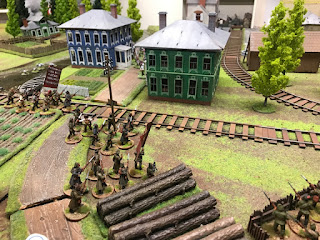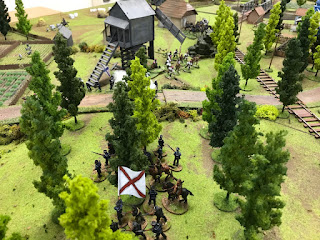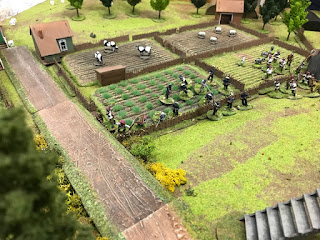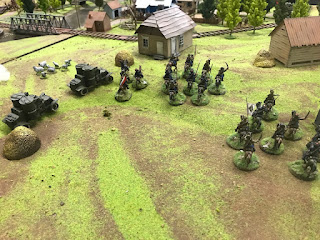These are some period photos of Admiral Kolchak's forces in Siberia. This first one is the most commonly found in a web search, showing a very ragged and desperate looking bunch.
Their clothes are torn, mismatching and they look either dirty or very sun-tanned. At least they have footwear, which is better than some of their peers.
These next three shots show troops on review. In the first, the men are well equipped and very regular with standard issue greatcoats, ammunition pouches and headgear. The men look recently re-equipped and maybe this was taken in early 1919, before or during the great spring offensive. The other ranks all wear the distinctive cap with ear flaps that was widely issued in the Siberian army. No unit insignia can be seen but the striped flag on the right may be the orange and black of St George. That might indicate these men were raised from the KOMUCH forces, and are just possibly some of the Kappelevtsy.
These troopers below are carrying swords and wearing long boots, so are probably a cavalry unit without their horses. The style of uniforms seems quite consistent but the colouring can be seen to vary a lot, even in this black and white photo. They are probably still wearing their wartime uniforms or have been equipped from mixed stores.
These appear to be infantry again but don't have standard greatcoats. Instead they are wearing a sheepskin coat or similar and mostly have standard army caps. They also look bigger and stronger than the ragged half starved lot we started with.
These next two images show the troops in summer, well clothed and relaxing in the sunshine. The great variety of styles and
colours is noteable. These photos were probably taken some time in spring or summer 1919 before the great ice march. Men in both pictures wear a variety of uniform styles and headgear. Several can be seeen wearing the Siberian caps. Two-coloured badges or ribbons are visible on their hats, probably the green and white cap badges and ribbons of the Siberian Army. Shoulder boards can be seen and at least some of them may well be coloured.
This last image has lots of intersting detail. First the soldiers are very young. All seem well under eighteen years old, some may be as young as ten or eleven. Perhaps they were a unit formed from cadets or a school. However, the boy seated centrally has already had time to earn the medal on his chest. The award is probably a cross of St George, given for 'undaunted courage'. So he, at least, may be a veteran of one or more engagements. The boy on the left has his reloading clips threaded through his bandolier for quick access in battle, possibly suggesting he has some experience too.
Their
headgear is mostly animal fur or woolen winter hats, with the medal
wearer possibly having a floppy field cap, Notable is the one boy in a
pilotka. This cap is more synonymous with the later soviet era but was
relatively common during the civil war period as well.
One last thing to note is that several of the boys carry cut down versions of the standard M91 Mosin three line rifle. I don't think a true carbine version shorter than the Dragoon model officially existed at this time, so these are probably field variants. Presumably the unit armourers were trying to help accomodate for the smaller stature of their soldiers. Experience in WW1 did lead to shorter rifles in the 20s and 30s with some older Mosin rifles being cut down when being reconditioned at the central armouries. So this might have been a widespread field practice. However, a full size 7.62x54R bullet in a short carbine rifle has a fierce recoil, due to the reduced weight, and a large muzzle flash, as the powder is not all burned up by the time the bullet leaves the barrel. See here.
Added notes to correct my suppositions from Cuprum here.
1) Soldiers of the Western army of Kolchak after the fighting. Summer
1919. This state of uniform is typical for both the White and Red Army
after prolonged hostilities.
2) Kolchak bypasses the formation of
the Siberian Assault Brigade. 1919 year. The black and orange flag
really means Army Headquarters.
3) Unknown cavalry unit. It can
be assumed with a high degree of probability that these are not
Cossacks, but regular cavalry, since their weapons are not of the
Cossack type.
4) Kolchak receives a parade of troops in the city
of Tobolsk, 1919. The soldiers have wonderful winter uniforms -
sheepskin fur coats.
5 - 6) Soldiers of the Siberian Corps (the former army of the Siberian Regional Government).
7)
These are cadets of the Siberian Cadet Corps, Omsk. 1919 They had to
take part in the battle only during the retreat of the Whites to the Far
East. They had to repel the attacks of the Red partisans on the
retreating army, which they were part of.







